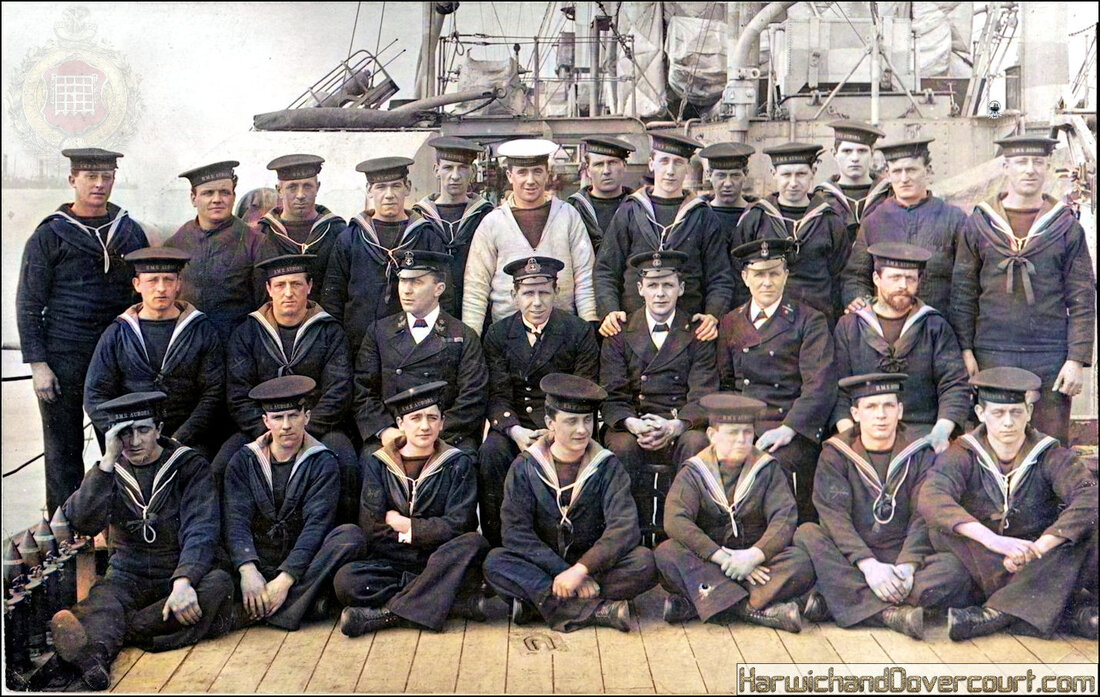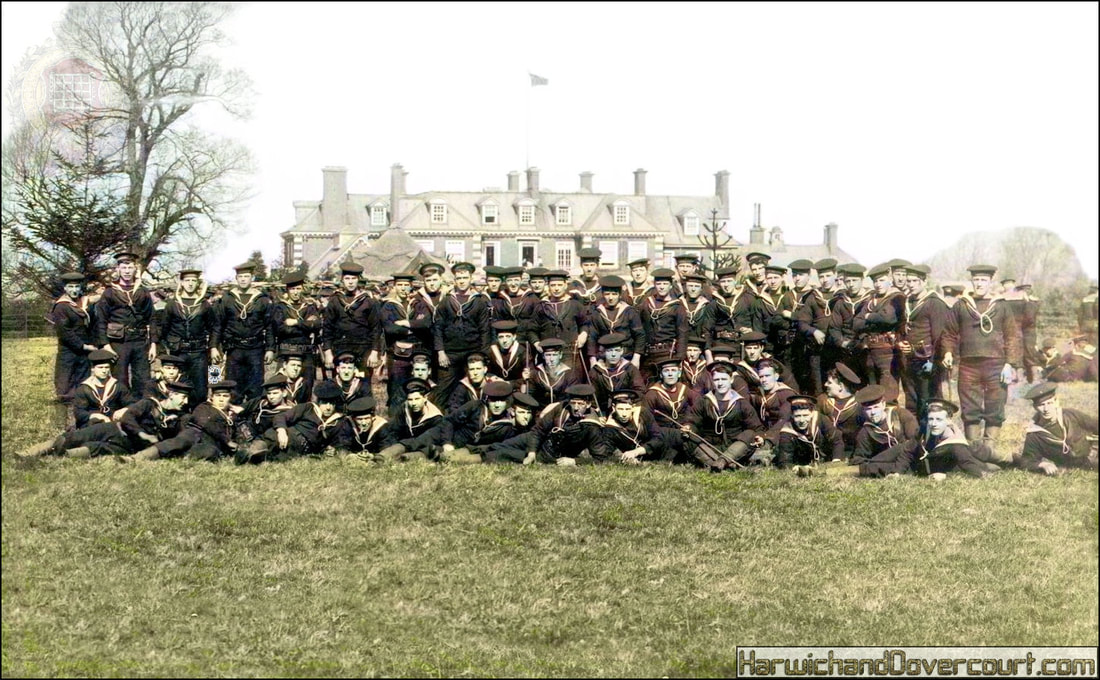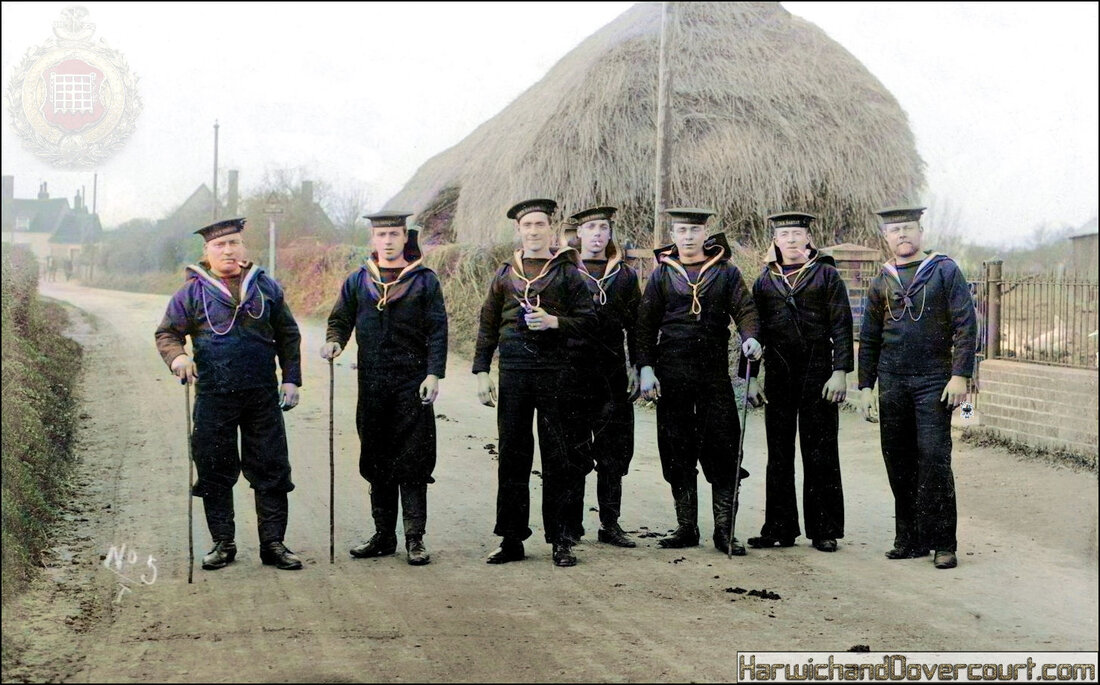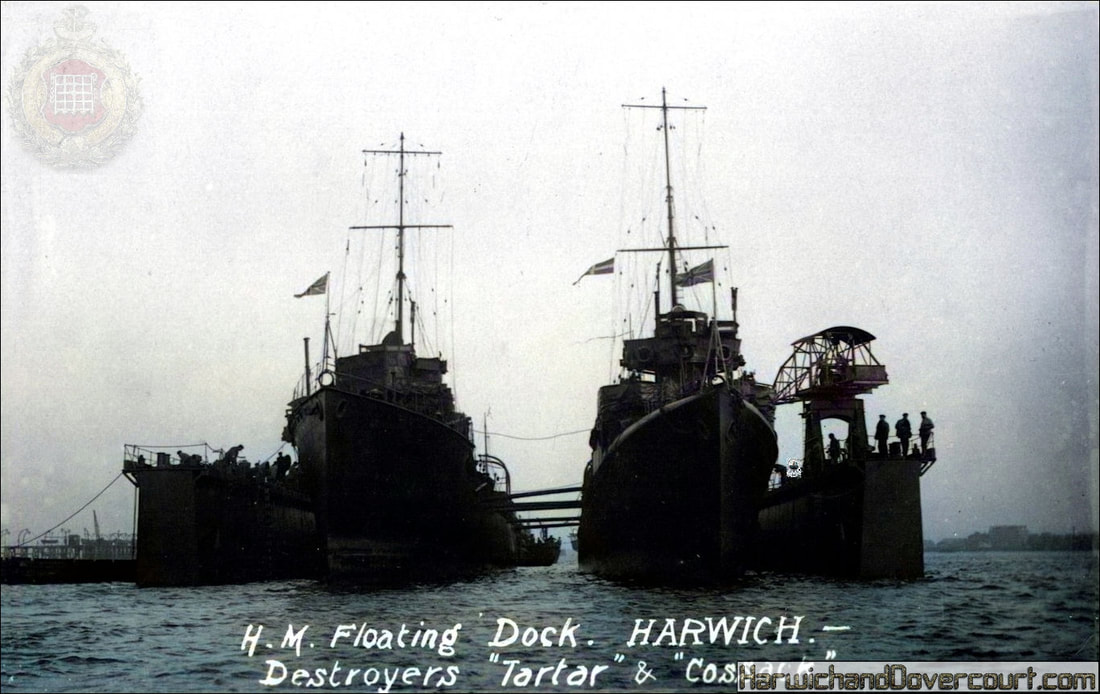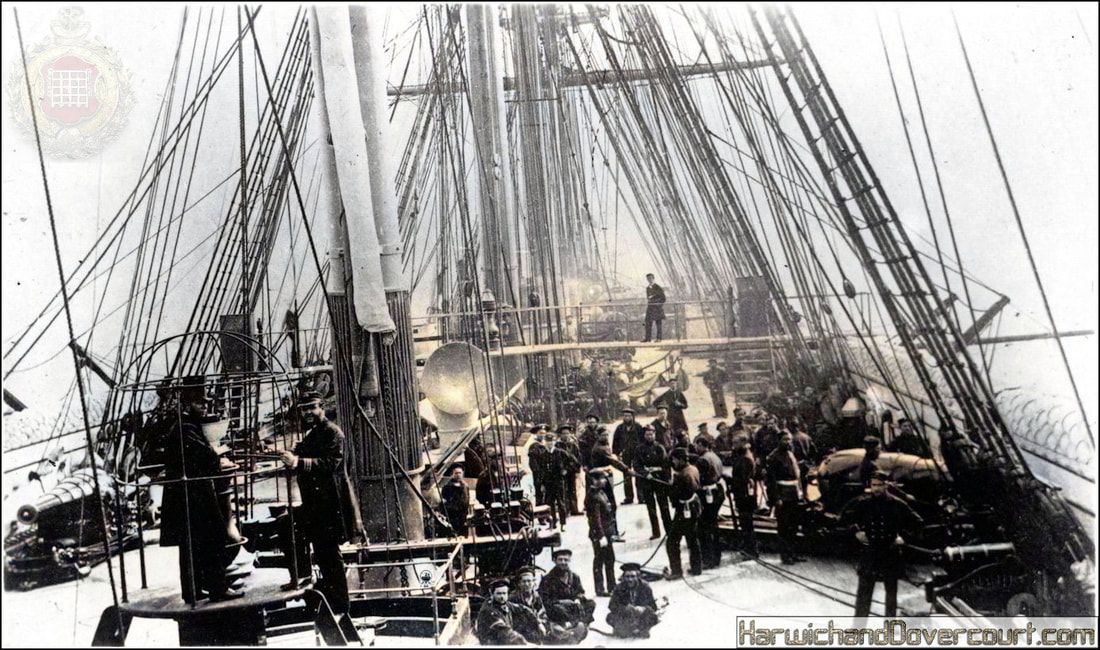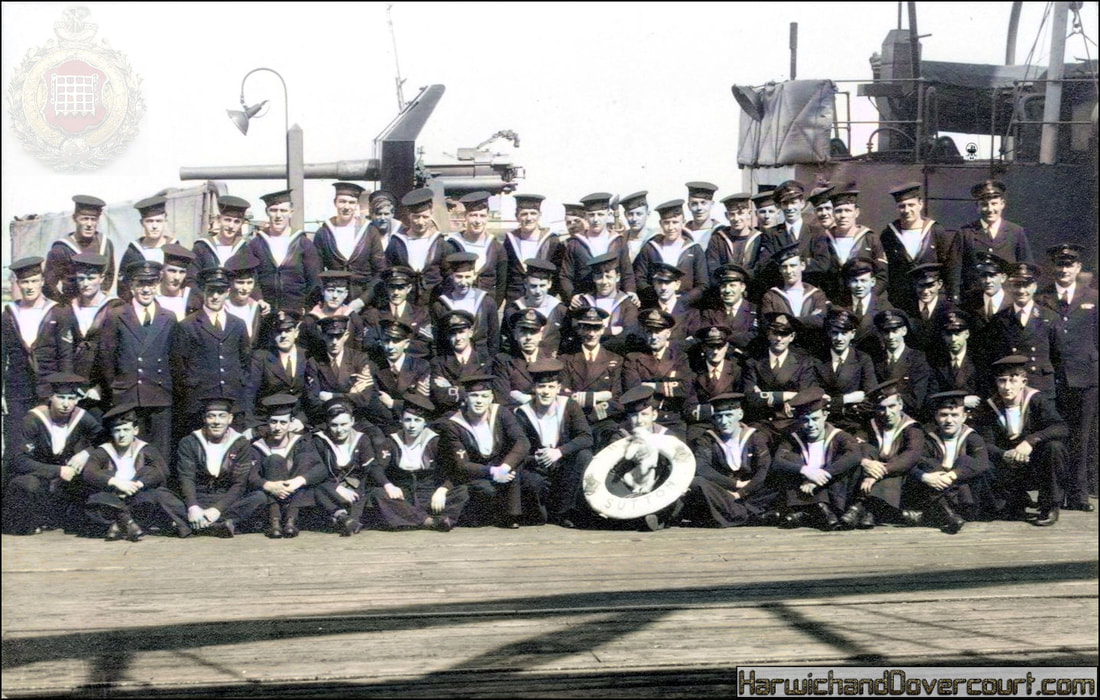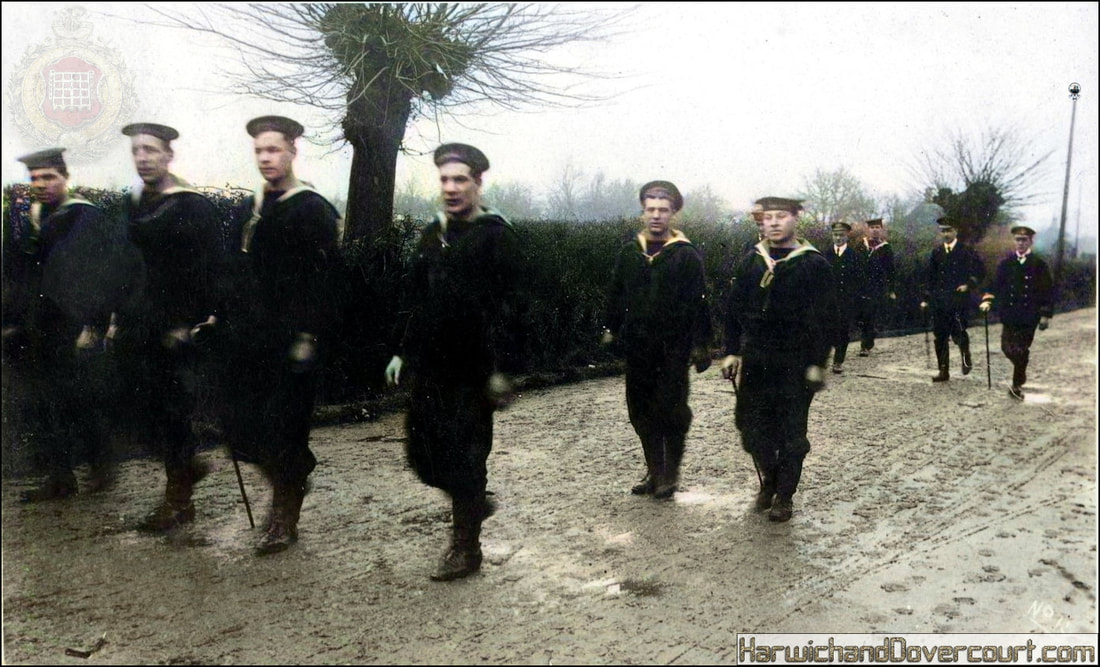Ships Crews & Landing Parties
H.M.S. Africa & H.M.S. Cornwall (1916) A.E. Qwen H&D FW
~ H.M.S. Aurora Crew (1914) F.G. Steggles H&D ~
~ H.M.S. Blanche Ships Crew at Michaelstowe Hall, Ramsey H&D ~
The Crew of HMS Blanche at Michaelstow Hall, near Ramsey
To celebrate the Battle of Jutland in 1916, a local connection to that historic event.
H.M.S. Blanche was a Blonde Class Light scout cruiser and was present at Jutland (although she didn't fight).
She was converted to a mine-layer in 1917. Commissioned in 1909 until she was sold for scrap in 1921.
The crew can be seen here posing at Michaelstow Hall, near Ramsey, armed with a variety of weapons (how things have changed, as members of the Royal Navy are not even allowed to wear their uniform in public these days) and taking the chance for rest and relaxation and the odd cigarette !
To celebrate the Battle of Jutland in 1916, a local connection to that historic event.
H.M.S. Blanche was a Blonde Class Light scout cruiser and was present at Jutland (although she didn't fight).
She was converted to a mine-layer in 1917. Commissioned in 1909 until she was sold for scrap in 1921.
The crew can be seen here posing at Michaelstow Hall, near Ramsey, armed with a variety of weapons (how things have changed, as members of the Royal Navy are not even allowed to wear their uniform in public these days) and taking the chance for rest and relaxation and the odd cigarette !
~ H.M.S. Boadicea Walking Party, Ramsey, Essex (1911) F.Wallis H&D ~
Royal Navy Walking Party from H.M.S. Boadicea, at Ramsey, Harwich, Essex July 1911
H.M.S. Boadicia was completed in June 1909, the first turbine-driven cruiser in the Royal Navy.
HMS Boadicia was commissioned to wear the broad pennant of the Commodore, commanding the 1st Destroyer Home Fleet, based at Harwich.
Publisher of the postcard was F.Wallis, Little Oakley (No 4).
Postcode for this location is CO12 5EY
H.M.S. Boadicia was completed in June 1909, the first turbine-driven cruiser in the Royal Navy.
HMS Boadicia was commissioned to wear the broad pennant of the Commodore, commanding the 1st Destroyer Home Fleet, based at Harwich.
Publisher of the postcard was F.Wallis, Little Oakley (No 4).
Postcode for this location is CO12 5EY
~ H.M.S. Canterbury Red Cross Flag Day at Parkeston Quay ~
Red Cross Flag Day aboard the HMS Canterbury (of the Harwich Force) at Parkeston Quay in 1917
Original photographic postcard 1st world war Red cross flag day collectors with sailor of HMS Canterbury.
Flag Days were the idea of Agnes Morrison, who started the Our Day collections in September 1914. They were organised mainly by the Red Cross and volunteer collectors to raise funds for wounded soldiers, war widows and prisoners of war. Supporters were encouraged to buy pin-flag badges and, on days dedicated to the corresponding funds of the allies, women sold flags wearing appropriate national dress.
HMS Canterbury was a C-class light cruiser of the British Royal Navy, part of the Cambrian sub-group and unlike the rest of the subclass she was armed with six torpedo tubes instead of the usual four.
Laid down in October 1914, she was launched on December 21, 1915 and commissioned into the navy in April 1916 before being attached to the Grand Fleet, commanded by Captain Percy M. R. Royds. Her first major action was the Battle of Jutland on 31 May to 1 June, which she survived, she was then assigned to the 5th Light Cruiser Squadron, operating with the Harwich Force to defend the eastern approaches to the English Channel.
On 5 June 1917, whilst serving with the Harwich force she sank the German torpedo boat S20 off the Belgian coast before being assigned to operate in the Aegean in 1918, where she saw out the rest of the war without incident.
She was considered obsolete by 1934, and was sold on July 27, 1934 to Metal Industries of Rosyth for breaking up, However her bell survived and is at Canterbury Cathedral.
Original photographic postcard 1st world war Red cross flag day collectors with sailor of HMS Canterbury.
Flag Days were the idea of Agnes Morrison, who started the Our Day collections in September 1914. They were organised mainly by the Red Cross and volunteer collectors to raise funds for wounded soldiers, war widows and prisoners of war. Supporters were encouraged to buy pin-flag badges and, on days dedicated to the corresponding funds of the allies, women sold flags wearing appropriate national dress.
HMS Canterbury was a C-class light cruiser of the British Royal Navy, part of the Cambrian sub-group and unlike the rest of the subclass she was armed with six torpedo tubes instead of the usual four.
Laid down in October 1914, she was launched on December 21, 1915 and commissioned into the navy in April 1916 before being attached to the Grand Fleet, commanded by Captain Percy M. R. Royds. Her first major action was the Battle of Jutland on 31 May to 1 June, which she survived, she was then assigned to the 5th Light Cruiser Squadron, operating with the Harwich Force to defend the eastern approaches to the English Channel.
On 5 June 1917, whilst serving with the Harwich force she sank the German torpedo boat S20 off the Belgian coast before being assigned to operate in the Aegean in 1918, where she saw out the rest of the war without incident.
She was considered obsolete by 1934, and was sold on July 27, 1934 to Metal Industries of Rosyth for breaking up, However her bell survived and is at Canterbury Cathedral.
~ H.M.S. Centaur Football Team, Harwich (1916) Entente Sudio H&D ~
~ H.M.S. Cossack & H.M.S. Tartar Walking Party, Ramsey, Essex (1911) H&D ~
Royal Navy Walking Party from H.M.S. Cossack & HMS Tartar, at Ramsey, Harwich, Essex 1912 (Wallis No 5)
H.M.S. Tartar was a Tribal class destroyer of the Royal Navy launched in 1907 and sold in 1921.
During the First World War she served in the North Sea and the English Channel with the 6th Destroyer Flotilla.
H.M.S. Cossack was also a Tribal class destroyer of the Royal Navy launched in 1907 and sold in 1919.
Postcode for this location is CO12 5EY
H.M.S. Tartar was a Tribal class destroyer of the Royal Navy launched in 1907 and sold in 1921.
During the First World War she served in the North Sea and the English Channel with the 6th Destroyer Flotilla.
H.M.S. Cossack was also a Tribal class destroyer of the Royal Navy launched in 1907 and sold in 1919.
Postcode for this location is CO12 5EY
~ H.M. Floating Dock, Harwich - Destoyers HMS Tartar & HMS Cossack. (1911) H&D ~
The two images above are most likely linked by both ships being repaired at the same time & the Royal Navy crews being given "Shore Leave" while the work was completed.
~ H.M.S. Dido - Man's Rotting Hand, Harwich (1917) H&D ~
The Peril's of War
A sailor's hand "rotting way" through handling an aircraft bomb at Harwich in July 1917 ~ H.M.S. Dido
A sailor's hand "rotting way" through handling an aircraft bomb at Harwich in July 1917 ~ H.M.S. Dido
~ H.M.S. Minotaur Crew on Deck Duties & Firing Practice (1900) H&D ~
~ H.M.S. Sutton Crew, Harwich, Essex (1940) H&D ~
On Board HMS Sutton, Harwich, Essex, in 1940
Mine Sweeping Crew aboard HMS Sutton by J A Saunders of Dovercourt.
HMS Sutton (J 78) - was a Old Hunt-class Minesweeper, she was a Class coal burning minesweeper ordered from MacMillan of Dunbarton in May 1917 and laid down on 6th July 1917
B a t t l e H o n o u r s : Dunkirk 1940 - Normandy 1944.
In December 1939, she was deployed at Harwich for mine-sweeping activities, off the East Coast to ensure convoy routes were kept clear of mines, part of the 4th Mine-sweeping Flotillas. In April 1941, she was transferred to Granton, near Edinburgh for mine-sweeping off Scottish East Coast.
HMS SUTTON remained in Reserve until 1946 when she was placed on the Disposal List. The ship was sold to Dohmen and Habets of Ghent in July 1947 and towed to Belgium for Demolition.
Mine Sweeping Crew aboard HMS Sutton by J A Saunders of Dovercourt.
HMS Sutton (J 78) - was a Old Hunt-class Minesweeper, she was a Class coal burning minesweeper ordered from MacMillan of Dunbarton in May 1917 and laid down on 6th July 1917
B a t t l e H o n o u r s : Dunkirk 1940 - Normandy 1944.
In December 1939, she was deployed at Harwich for mine-sweeping activities, off the East Coast to ensure convoy routes were kept clear of mines, part of the 4th Mine-sweeping Flotillas. In April 1941, she was transferred to Granton, near Edinburgh for mine-sweeping off Scottish East Coast.
HMS SUTTON remained in Reserve until 1946 when she was placed on the Disposal List. The ship was sold to Dohmen and Habets of Ghent in July 1947 and towed to Belgium for Demolition.

